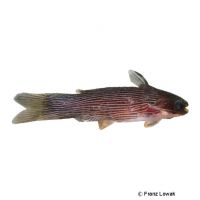Pinstripe Woodcat (Tatia strigata)
| Pinstripe Woodcat Tatia strigata | |
|---|---|
| Name | Pinstripe Woodcat |
| Name Lat. | Tatia strigata |
| Family | Driftwood Catfishes |
| Family lat. | Auchenipteridae |
| Order | Catfishes |
| Order lat. | Siluriformes |
| Origin | South America |
| Habitat | Streams |
| Diet | Carnivore |
| pH | 6.5-7.5 |
| Behavior | Nocturnal, peaceful |
| Keeping | Pair, group |
| Care Level | Moderate |
| Reproduction | Cave spawner |
| Breeding | Moderately difficult |
| Life Span | N/A |
| Protection | No |
| Metric Units | |
| Size | 6 cm |
| Temperature | 22-28 °C |
| Hardness | 5-15 °dH |
| Aquarium | 80 l |
| US Units | |
| Size | 2.4" |
| Temperature | 72-82 °F |
| Hardness | 89-267 ppm |
| Aquarium | 20 gal |
Distribution and habitat
The nocturnal white-striped trughorn catfish are common in the middle Amazon River basin and the Rio Negro river system. They live mostly near the banks of small rivers and streams, where they hide during the day in caves and in crevices and joints in driftwood.
Maintenance
The aquarium should have border planting, with many hiding places, such as stone caves (e.g. perforated rock), tubes and roots, as well as free sand areas and provide sufficient swimming space. A soft substrate covered with some foliage (e.g. sea almond leaves), subdued light (floating plants) and a weak to medium current is ideal
No ammonia, ammonium and nitrite should be detectable, the nitrate value should not exceed 100 mg/l. To ensure the water quality and oxygen content, a filter and heater adapted to the aquarium size is required, as well as lighting for the species-appropriate day-night rhythm of the animals.
Diet
They are problem-free in feeding. The food supply consists of live or frozen food, such as daphnia, artemia, mysis and mosquito larvae or a commercial frozen food mix for catfish. Sinking, high-protein dry foods for catfish, such as pellets, granular and tablet foods are also well accepted. Feeding should be done with the lights off or in the dark.
A regular and varied diet promotes health and increases resistance. Only as much should be fed as is eaten overnight.
Behaviour and compatibility
They are compatible and sociable fish and should be kept in pairs or better in a group of 3-5 animals. However, keeping a group is only recommended in a larger and richly structured tank. They are very well suited for a South America community tank with e.g. armored catfish, tetras or dwarf cichlids
Basically, only compatible fish species with similar demands on water condition and water temperature should be socialized.
Sex dimorphism
Adult males have an anal fin (gonopodium) that has been converted to a mating organ. The females appear more rounded.
Reproduction and breeding
Fertilization of the eggs occurs through the male's gonopodium inside the female. They can store the sperm in their genital tract for months, ready for fertilization. Females spawn in burrows (clay tubes, catfish burrows) the eggs in loose pads held together by a sticky mucus. The larvae hatch after 3-4 days and swim free after another 3-4 days. The parents do not perform any special brood care.
Fry must be fed several times a day with special rearing food (Artemia nauplii). In community tanks breeding is hardly possible, because the fry are easy prey.
Important
The stripe pattern is developed individually differently in each animal and makes the species distinctive.
With a red night light, the fish can be well observed when foraging.
When catching, use fine-meshed nets if possible, transparent cups are better so that the hard rays (with barbs) of the pectoral and dorsal fins do not get caught
The well-being of the fish should be checked regularly. Temperature should be checked daily, pH, hardness and nitrate levels at least every 14 days. Regular partial water changes are recommended, even if the contaminant level has not yet reached the upper limit. Sudden changes in water quality should be avoided. Newly introduced fish must be accustomed slowly to the water in the aquarium.
Further literature can be found in your pet store.
References
Text: petdata; Image: Franz Lowak
Source: BMELV (1998): Tierschutzgutachten - Haltung von Zierfischen (Süßwasser); ENGELMANN (2005): Zootierhaltung - Tiere in menschlicher Obhut: Fische, Verlag Harri Deutsch
- Gemäß § 21 Abs. 5 Tierschutzgesetz idgF
